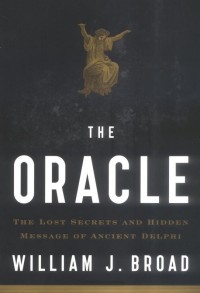The Oracle: The Lost Secrets and Hidden Message of Ancient Delphi

 By William J. Broad
By William J. Broad
The Penguin Press, Published by the Penguin Group, New York, 2006 Click to Buy this Book!
From the Prologue: “This book is about a voice from the remote past that has come back to question the metaphysical assumptions of our age, to urge us to look beyond the claims of science and reexamine our attitudes toward spirituality, mysticism, and the hidden powers of the mind… The Oracle is back today because a team of American scientists managed to uncover one of her greatest secrets and, in the process, to restore her reputation and voice. It turns out that she got high … Science may be our religion. But the dirty little secret, reflected in the wisdom of the Oracle, is that it is more a loose collection of insights and slogans than a universal explanation for what is real.” The prologue is clearly pointing to journalist William Broad’s realization of a dichotomy between the tenets of modern science that attribute the highest values and most meaningful experiences of the soul and spirit to physical causes only, and his awareness of the unseen spiritual foundations of all existence, an awareness that must have increased during the writing of The Oracle, especially through the research required for the earliest time periods of ancient Greece. The primary subject of the book, after it provides a clear history of the Delphic Oracle from 1000–800 BC (the author uses BCE and CE) to the time of Julian the Apostate, as well as accounts of the earliest archaeological excavations at Delphi, is a detailed biography of the geologist Jelle Zeilinga de Boer (b. mid–1930s) and his discovery of the evidence of the intoxicating hydrocarbon gases ethane, methane and ethylene that rose along the crossing faults beneath the temple, while in very minute quantities. Joining de Boer in the work of the discovery was John R. Hale, an archaeologist, Jeff Chanton, a chemist, and Henry Spiller, a medical toxicologist.
The book reflects its extensive research, with seven chapters, a Chronology, Notes, a Selected Bibliography, a Glossary, Acknowledgments and an Index. The first chapter, titled “Center of the Universe,” includes illustrations, diagrams and a map, and offers many intriguing facts, such as the meaning of the Greek word Pytho: “Python’s slaying [by Apollo], in addition to providing a dramatic narrative for Apollo’s new sanctuary, gave Delphi its other name — Pytho, from the Greek word for ‘to rot,’ a reference to the decay of the snake’s body. Pytho came to refer to the sacred region at the foot of Parnassus, while the name Delphi applied only to the sanctuary and, in time, the nearby town. The Oracle herself came to be known as the Pythia.” The Sun god, Apollo, like Saint George of later tradition, had to overcome the regional dragon, the beast of the earth, and also, to a certain degree, the beast’s power within the physical structure of the human being, in order to establish the divine impetus and direction for the coming Greco-Roman cultural age (in Anthroposophy, 747 BC to 1413 AD). More »